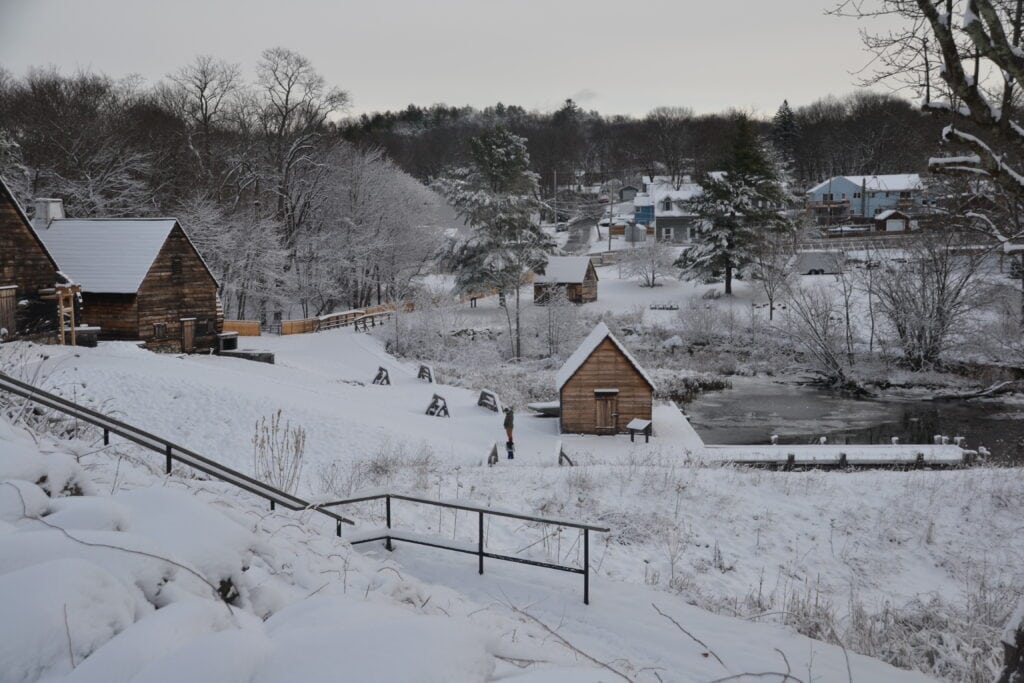Here’s what’s blooming in town this week to make your walks more enjoyable
By Laura Eisener
Whoever was dreaming of a white winter solstice had their dreams come true – also a white Christmas, beginning of Chanukah, Kwanzaa and a few other holidays mixed in these last few weeks, as the cold weather kept the coating of snow from melting away until the 29th to 30th. Since the snowfall was light, there was very little shoveling needed, but it still provided a winter wonderland atmosphere all over town.
There have been several sunny days and continuously changing scenes of interest around town as the temperatures fluctuate dramatically. The snow remained from the solstice for several days, and the pond surfaces were frozen until the 28th or so, then the warm air temperatures brought dense fog in low-lying areas, and the thin ice melted away. At 1:00 on Dec. 30, Birch Pond was concealed by dense fog, but 20 minutes later it had completely cleared to reveal a no-longer-snow-and ice-covered pond surface, but a still surface that reflected the trees and sky.
On the warmer days, swans (Cygnus olor) were often seen on a few of the ponds, especially Hawkes Pond and Birch Pond, and occasionally on the Saugus River. These are not native birds but were introduced to North America in the 19th Century, and escaped populations have somewhat naturalized. They are among the birds mentioned in the very old “Twelve Days of Christmas” song.
The 12th day of Christmas, also sometimes called epiphany, Three Kings’ Day or Little Christmas, will be January 6. The evening before, January 5, is often celebrated as Twelfth Night.
People have varying traditions about how long they choose to keep decorations up, and in some cases it depends on practical considerations like the need to take down a live tree before the needles dry out enough to be a fire hazard. For some, the decorations come down on the 26th; for others they come down by New Year’s Eve; for still others they remain up until at least January 6, and for still others the date is Candlemas – also known as Groundhog Day – February 2.
Indoor plants like amaryllis and poinsettias provide some brilliant color during the winter when bright colors outdoors are scarce. With a little effort they may be enjoyed for several years to come.
Most amaryllis plants that you may buy in the early winter season have flower buds already formed inside the bulb. Potted amaryllis need to be watered regularly, although waxed bulbs can bloom without extra water because the wax coating prevents so much moisture from evaporating away. Each stalk produces four blossoms or occasionally five. A second stalk may follow soon after the first one in some cases, and usually some leaves begin to develop around the same time. Once the flowers fade, the stalk can be cut off – it contains a lot of moisture so you may want to carry it upside down to the compost pile to keep it from dripping on the floor.
In order to keep the bulb alive for flowers next year, the potted bulb and its leaves need to be kept in a window to get sunlight at least until late spring when the weather is warm. By that time the leaves will be very long – it can be kept in the window all summer or put outside to allow the leaves to soak up sunlight. If this does not happen, flower buds cannot develop. Once the leaves fade in fall, the bulb can be kept in the dark for six weeks or so (it needs to be kept indoors since it cannot survive our cold weather outdoors).
I don’t usually make a great effort to get the buds to open on Christmas, since it is even more enjoyable to have flowers opening in late January or February, when the festive mood may have begun to wear off. After a minimum of six weeks of dormancy, you can check the bulbs for new buds, at which point they should be brought into a sunny window and watered as the cycle begins again. At this point I have eight or nine amaryllis bulbs summered over, and most of them can be expected to bloom sometime this winter.
It is difficult to determine exactly when they will bloom – some may obligingly bloom in December, while others may not show signs of life until January or March, or even occasionally April. Last year I had a white one bloom at Easter, and the final blossom did not open until May! But these pretty flowers are not strictly associated with a single holiday and are welcome whenever they decide to flower. I have several in a dark box that I check every now and then (if there is no green showing they don’t need to be watered), and once green buds appear at the top of a bulb that pot comes out of the box and into a bright location and starts to get regular water again.
Editor’s Note: Laura Eisener is a landscape design consultant who helps homeowners with landscape design, plant selection and placement of trees and shrubs, as well as perennials. She is a member of the Saugus Garden Club and offered to write a series of articles about “what’s blooming in town” shortly after the outbreak of the COVID-19 pandemic. She was inspired after seeing so many people taking up walking.




